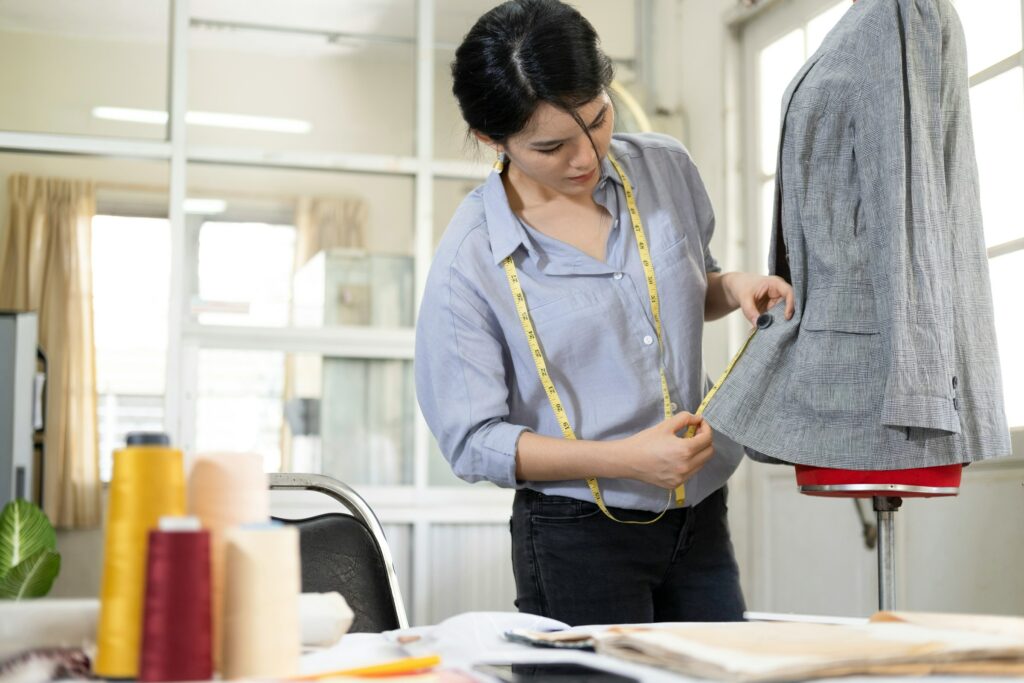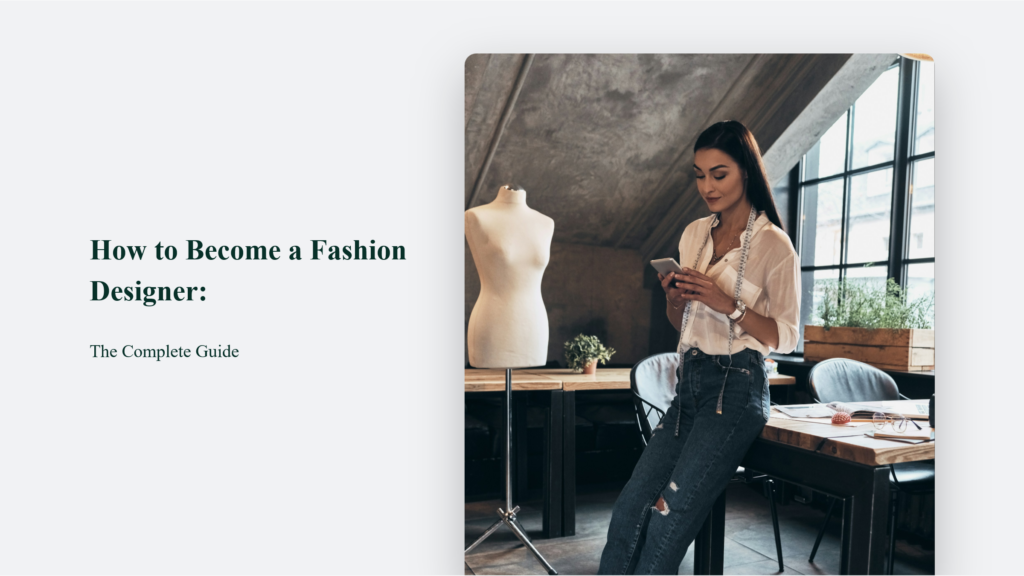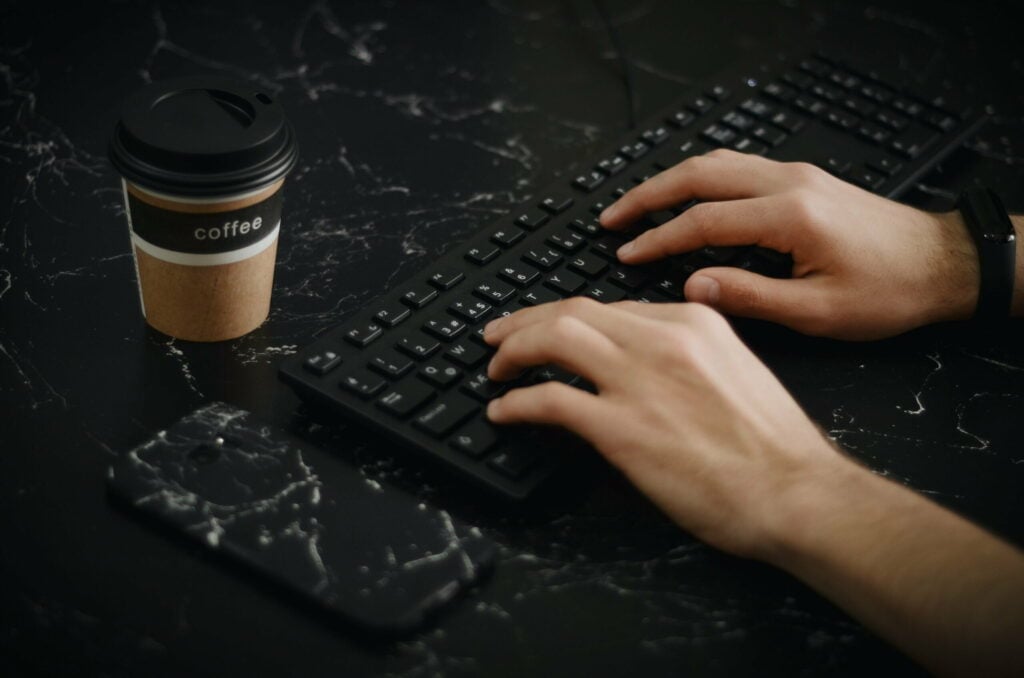

How to Become a Fashion Designer: The Complete Guide

As Seen On
Becoming a fashion designer is an exciting career path for creative individuals passionate about style and design. As a fashion designer, you get to bring your artistic vision to life through innovative clothing and accessory designs.
However, establishing a successful career as a designer requires dedication, skill development, and an understanding of the fashion industry. This comprehensive guide outlines everything you need to know on how to become a fashion designer.

How to Become a Fashion Designer:
Step 1: Earn a Fashion Design Degree
While not always required, most aspiring designers pursue a bachelor’s degree in fashion design or a related field like apparel design or merchandising. These 4-year programs teach essential technical skills like sketching, pattern drafting, sewing, and computer-aided design (CAD).
Students also study topics including:
- Textiles and fabrics
- Fashion history
- Trend forecasting
- Business and marketing
A design degree also allows you to build a portfolio – a collection of original sketches, illustrations, and photographs of completed garments. This portfolio is invaluable when applying for internships or jobs post-graduation.
When researching design programs, look for schools with strong industry connections that offer internship opportunities.
Step 2: Gain Hands-On Experience
Experience in the fashion industry is vital, even for recent graduates. Pursue internships at design firms, manufacturers, or merchandising companies to gain exposure and make professional connections.
Entry-level positions like design assistant, patternmaker, or sample sewer also provide on-the-job training. Take on freelance jobs to build your portfolio.
Step 3: Choose a Fashion Design Specialization
Most designers focus their skills and training in a particular area of the vast fashion industry. Common specializations include:
- Womenswear: Designing clothing and accessories for women
- Menswear: Designing clothing and accessories for men
- Childrenswear: Designing clothing and accessories for babies, kids, and teens
- Footwear: Designing shoes and boots
- Accessories: Designing items like jewellery, handbags, hats, and belts
- Technical Design: Creating technical sketches, patterns, and prototypesChoose an area that aligns with your unique interests, style, and talents.
Step 4: Develop Your Design Skills
Master both creative and technical competencies to prepare for a fashion design career. Essential skills include:
- Illustration: Bring design ideas to life through fashion sketches and drawings
- Sewing: Use industrial equipment to sew garments and samples
- Patternmaking: Draft paper patterns used to cut fabric pieces for construction
- CAD: Utilize computer-aided design software to create digital sketches and prototypes
- Trend Forecasting: Predict upcoming styles by analyzing past and current fashion trends
Continuously build on these fundamental skills even after formal education.
Step 5: Create an Eye-Catching Portfolio
A stand-out portfolio is vital for aspiring fashion designers to land jobs and freelance gigs. The portfolio should showcase your unique aesthetic and range of technical abilities.
Include 5-10 examples of your best work, such as:
- Original sketches and fashion illustrations
- Photographs of finished garments you designed and produced
- Patterns and technical drawings
- Details of textiles or embellishments used
- Artwork, paintings, or sculptures (if relevant)
Organize your pieces cohesively to present a consistent personal style.
Step 6: Network, Network, Network
Connections are invaluable for breaking into the competitive fashion industry. Attend trade shows, fashion weeks, industry events, and career fairs to connect with:
- Established designers
- Buyers and merchandisers
- Editors and journalists
- Photographers and stylists
- Potential employers
Social media also facilitates networking – follow industry influencers and companies to stay on their radar.
Step 7: Land Your First Job
Entry-level jobs provide a crucial stepping stone to advance your budding fashion design career. These roles include:
- Design Assistant: Supports lead designers by assembling research, fabric swatches, etc.
- Technical Designer: Creates detailed sketches, patterns, and prototypes for production
- Sample Sewer: Constructs prototypes and samples under a lead designer’s guidance
- Textile Designer: Prints original fabric patterns and designs textiles
Entry-level salaries generally range from $30,000 to $45,000 annually. Designers can progress to higher-paying roles like senior designer, creative director, or brand owner with dedication and skill.
Key Takeaways
Launching a fashion design career takes passion, technical know-how, perseverance, and a stand-out portfolio. Most designers have a bachelor’s degree in fashion or apparel design. Hands-on experience via internships provides exposure to the fast-paced industry.
Choose a specialization that fits your interests and talents. Continuously build your trend forecasting, sewing, CAD, and illustration skills.
Attending industry events and making connections is also critical for aspiring designers. A rewarding, stylish career can become a reality with hard work and dedication to mastering both the creative and business sides of fashion.
Frequently Asked Questions:
What degree do you need to be a fashion designer?
Most fashion designers have a bachelor’s degree in fashion design, fashion merchandising, apparel design, or a related field. These 4-year programs teach technical skills for constructing garments along with business knowledge.
What skills are most important for a fashion designer?
Important skills include illustration, trend forecasting, sewing, pattern drafting, and computer-aided design (CAD). Strong visualization, creativity, communication abilities, and business acumen are also vital.
What is the best way to start a career in fashion design?
Earning a relevant degree, interning at a design house or manufacturer, and continually building your portfolio provides the best foundation. Starting as a design assistant or sample sewer are common entry points.
Konger
Up until working with Casey, we had only had poor to mediocre experiences outsourcing work to agencies. Casey & the team at CJ&CO are the exception to the rule.
Communication was beyond great, his understanding of our vision was phenomenal, and instead of needing babysitting like the other agencies we worked with, he was not only completely dependable but also gave us sound suggestions on how to get better results, at the risk of us not needing him for the initial job we requested (absolute gem).
This has truly been the first time we worked with someone outside of our business that quickly grasped our vision, and that I could completely forget about and would still deliver above expectations.
I honestly can't wait to work in many more projects together!
Disclaimer
*The information this blog provides is for general informational purposes only and is not intended as financial or professional advice. The information may not reflect current developments and may be changed or updated without notice. Any opinions expressed on this blog are the author’s own and do not necessarily reflect the views of the author’s employer or any other organization. You should not act or rely on any information contained in this blog without first seeking the advice of a professional. No representation or warranty, express or implied, is made as to the accuracy or completeness of the information contained in this blog. The author and affiliated parties assume no liability for any errors or omissions.

